U.S. Export Sales Activity to China Slows
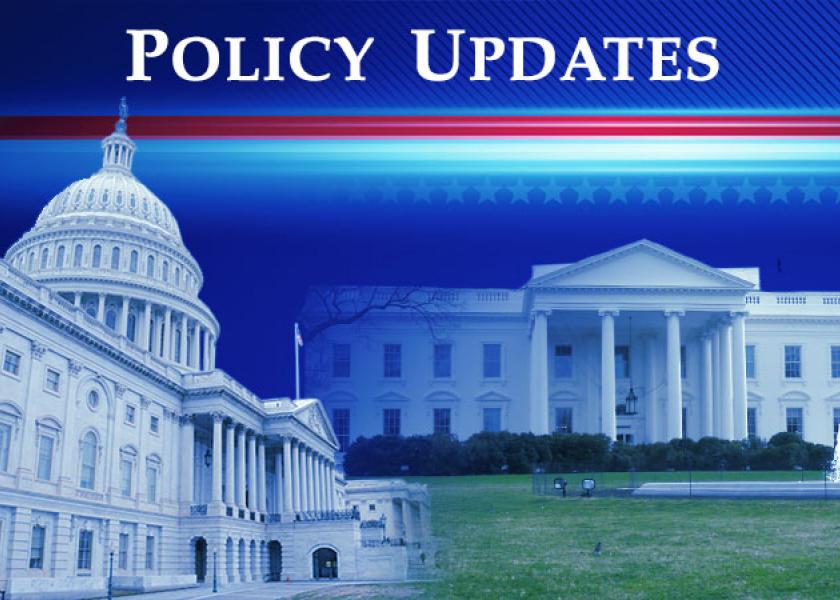
Global demand for biofuels to slow in decade ahead: report
|
In Today’s Digital Newspaper |
The personal-consumption expenditures price index, an inflation gauge closely watched by the Federal Reserve, rose 6.3% in May from a year earlier, the same as April’s annual rate. Core personal consumption expenditures prices, excluding food and energy, rose 4.7% from a year ago, slightly less than expected.
U.S. consumers boosted their seasonally adjusted spending by 0.2% in May, a slowdown from the revised 0.6% increase in April, according to a report this morning from the Commerce Department.
Personal income grew by 0.5% in May, the same as April’s rate. Adjusted for inflation, after-tax income declined by 0.1% in May, showing that wage increases have been struggling to keep up with price rises. Inflation-adjusted spending declined by 0.4% in April.
U.S. export sales activity to China slows. USDA data shows that sales of U.S. ag goods to China slowed in the week ending June 23. Activity for 2021-22 included net reductions of 9,309 tonnes of corn, net sales of 2,065 tonnes of sorghum, 16,402 tonnes of soybeans, and 25,414 running bales of upland cotton. There were no sales for 2022-23 reported. For 2022, USDA reported net sales of 4,526 tonnes of beef and 935 tonnes of pork.
Russian forces announced they had abandoned the strategic Black Sea outpost of Snake Island, in a major victory for Ukraine that could loosen the grip of Russia's grain export blockade, but other moves are underway that could free up Ukrainian grain exports. Details in Russia/Ukraine section.
Russian leader Vladimir Putin said that Russia would respond in kind if NATO deployed troops and infrastructure in Finland and Sweden after they join the U.S.-led military alliance.
Xi Jinping, China’s leader, is in Hong Kong to celebrate 25 years since the end of British rule. He hadn’t left the mainland since the pandemic started. He hailed the “vitality” of “one country, two systems” in arrival speech in Hong Kong, and endorsed it as a “good system.”
China’s economic activity expanded in June after three months of contraction, pointing to a modest recovery with the easing of Covid-19 restrictions.
Five Chinese companies were added to a U.S. export blacklist for allegedly helping Russia’s military.
Fed Chairman Jerome Powell said Wednesday that raising rates rapidly, even at the risk of recession, is necessary to avoid a worse economic fate: entrenched high inflation. We have more details below… and a list of inflation/recession-watch items to note.
ECB President Christine Lagarde: "I don't think we are going to go back to that environment of low inflation. There are forces that have been unleashed... that we're facing now that are going to change the picture and the landscape within which we operate.”
We finally have the payments paid to date via the renamed ERP (WHIP+) program and it’s a huge one: over $4 billion. USDA likely waited for an “event” to unveil the big taxpayer payout. Details in Policy section.
As expected, USDA Secretary Vilsack taps CCC for $1 billion for school meal programs.
USDA sent OMB a proposed rule for a new approach to determining livestock indemnities.
Democratic leaders are still discussing another budget reconciliation measure. We have updates on the topic via Bloomberg and the Washington Post.
OPEC members say the cartel and its allies have fallen far behind on their oil-production targets and are in their weakest position in recent years to help tame high crude prices. OPEC+ meets today and a slight boost in production prospects is expected.
Today’s dispatch has both sides of a debate on whether or not the U.S. should halt some oil product exports.
Global demand for biofuels to slow in decade ahead: report. Corn will become less important and sugarcane a more dominant feedstock for making ethanol in the coming decade, according to an agricultural outlook published jointly by the OECD and FAO on Wednesday. We have details and a link to the report in the Energy section.
The Supreme Court is set to issue its final two rulings of its current term, one on federal agency power to tackle climate change and the other on President Joe Biden's ability to end a hardline immigration policy begun under former President Donald Trump.
Ketanji Brown Jackson is set to be sworn in as a Supreme Court justice, making history as the first Black woman on the nation's top judicial body.
Israel’s government collapsed, which means the country will hold its fifth election since April 2019.
|
MARKET FOCUS |
Equities today: Global stock markets were mostly lower overnight. U.S. Dow is currently down around 450 points. In Asia, stock markets were mostly lower. In Japan, the Nikkei 225 fell 1.5% while in Hong Kong, the Hang Seng Index weakened by 0.5%. In mainland China, the Shanghai Composite Index was an exception, rising 1.1%. In Asia, Japan -1.5%. Hong Kong -0.6%. China +1.1%. India flat. In Europe, at midday, London -1.7%. Paris -2.3%. Frankfurt -2.4%.
U.S. equities yesterday: The Dow finished with a modest gain while the S&P 500 and Nasdaq ended weaker after a choppy trading session. The Dow rose 82.32 points, 0.27%, at 31,029.31. The Nasdaq was down 3.65 points, 0.03%, at 11,177.89. The S&P 500 eased 2.72 points, 0.07%, at 3,818.83.
The S&P 500 is on course to close out its worst first half of the year since the 1970s, as soaring inflation and rapidly rising interest rates raised the specter of recession.
Agriculture markets yesterday:
- Corn: December corn fell 5 1/2 cents to $6.53 3/4.
- Soy complex: November soybeans rose 15 3/4 cents to $14.78 1/4, the contract’s highest closing price since $15.10 1/2 on June 21. August soymeal rose $9.60 to $429.30, a two-month closing high. August soyoil rose 50 points to 69.50 cents.
- Wheat: September SRW wheat fell 6 cents to $9.30 and September HRW wheat rose 1 cent at $9.91 1/4. September spring wheat tumbled 12 1/4 cents to $10.28 1/2.
- Cotton: December cotton surged 400 points to 97.48 cents.
- Cattle: August live cattle sank 55 cents to $132.175, the contract’s lowest closing price since May 31, while August feeder futures sagged $1.10 to $170.725.
- Hogs: August lean hogs fell 25 cents to $103.575. The next CME lean hog index quote is expected to fall 40 cents to $111.24, down from a 10-month high.
Ag markets today: Corn and wheat futures (aside from HRW) extended Wednesday’s losses overnight, while soybeans pulled back from recent gains. As of 7:00 a.m. ET, corn futures were trading 5 to 6 cents lower, soybeans were 1 to 5 cents lower, SRW wheat was 2 to 4 cents lower, HRW wheat was 1 to 3 cents higher and HRS wheat was 3 to 5 cents lower. Front-month U.S. crude oil futures were around 50 cents lower and the U.S. dollar index was about 250 points higher this morning.
Technical viewpoints from Jim Wyckoff:
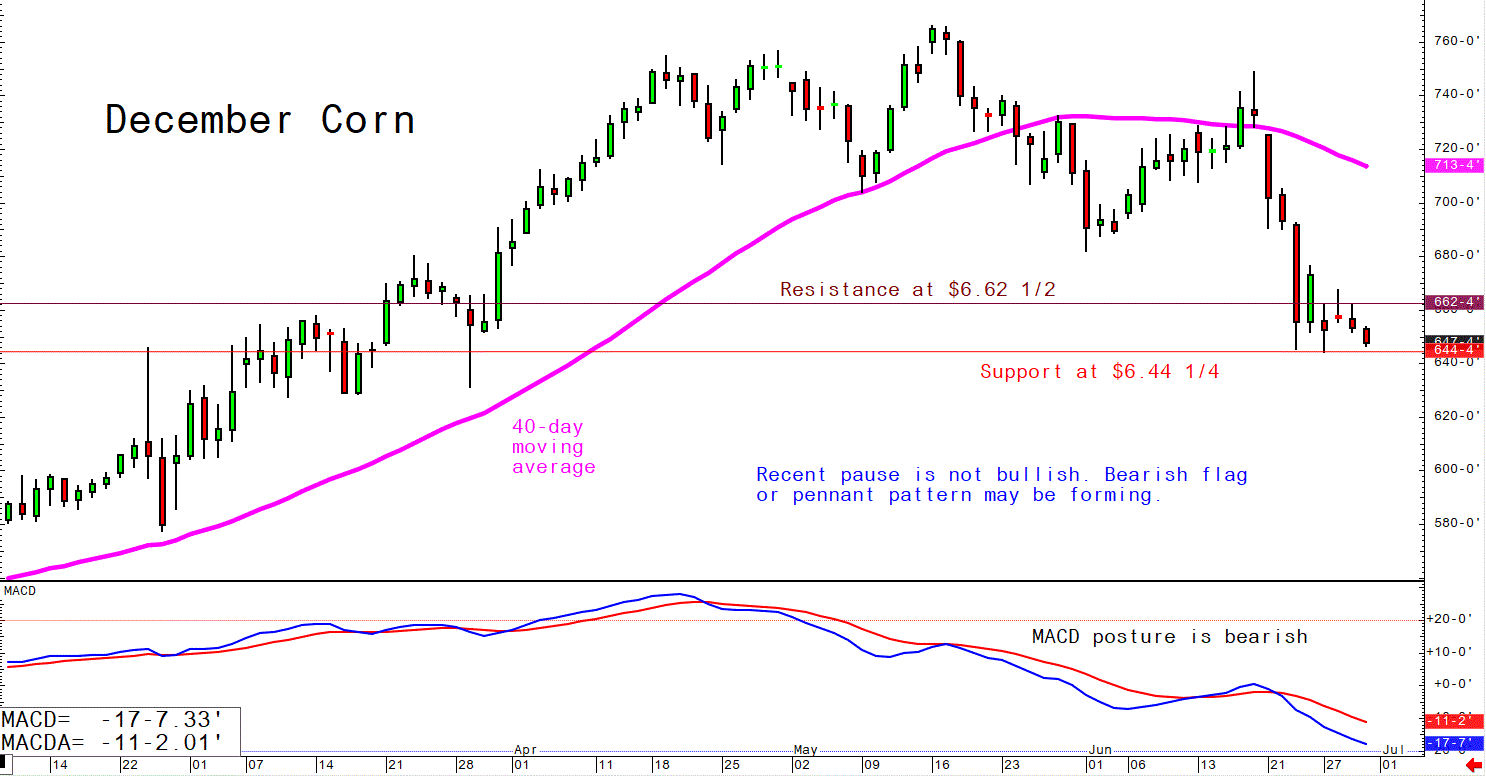
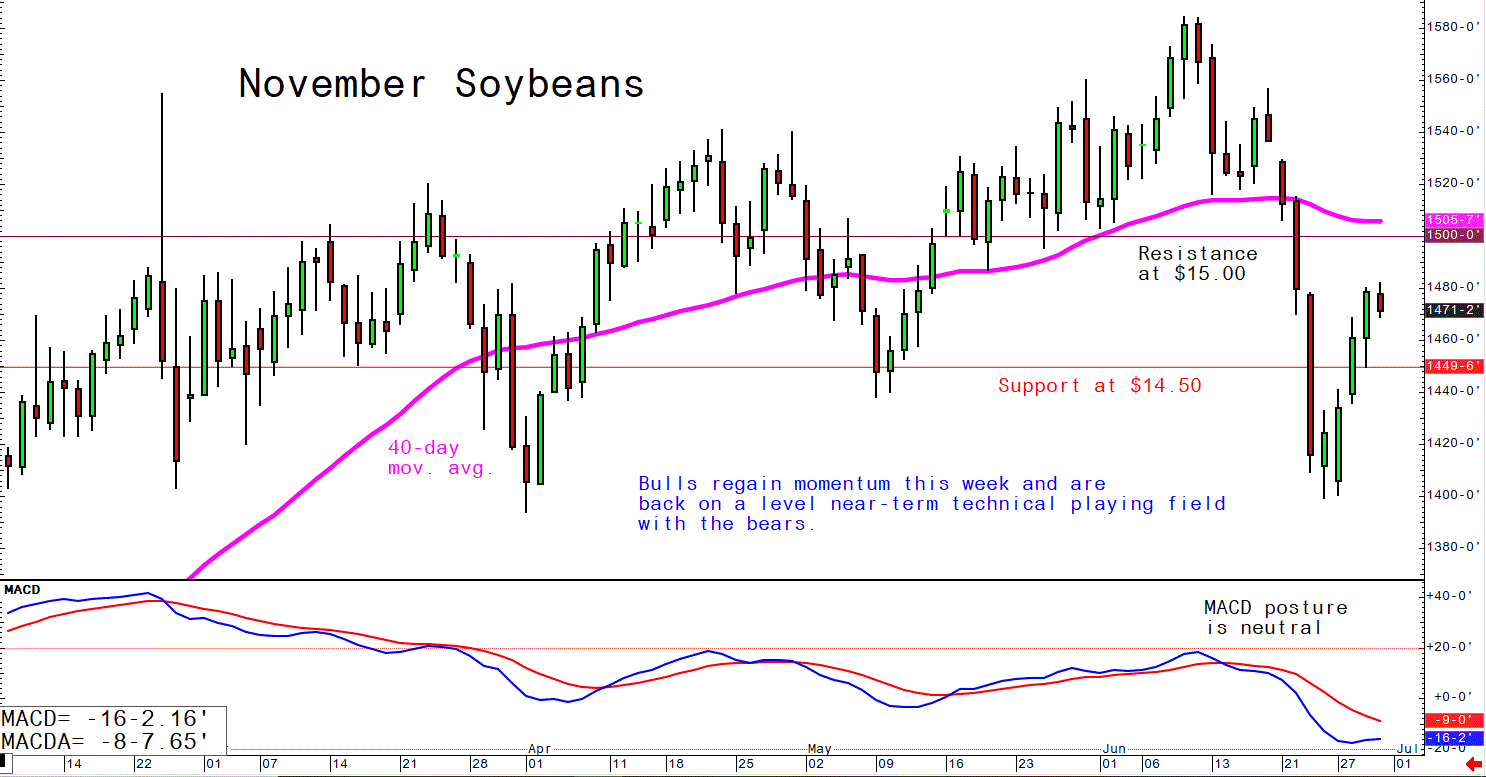


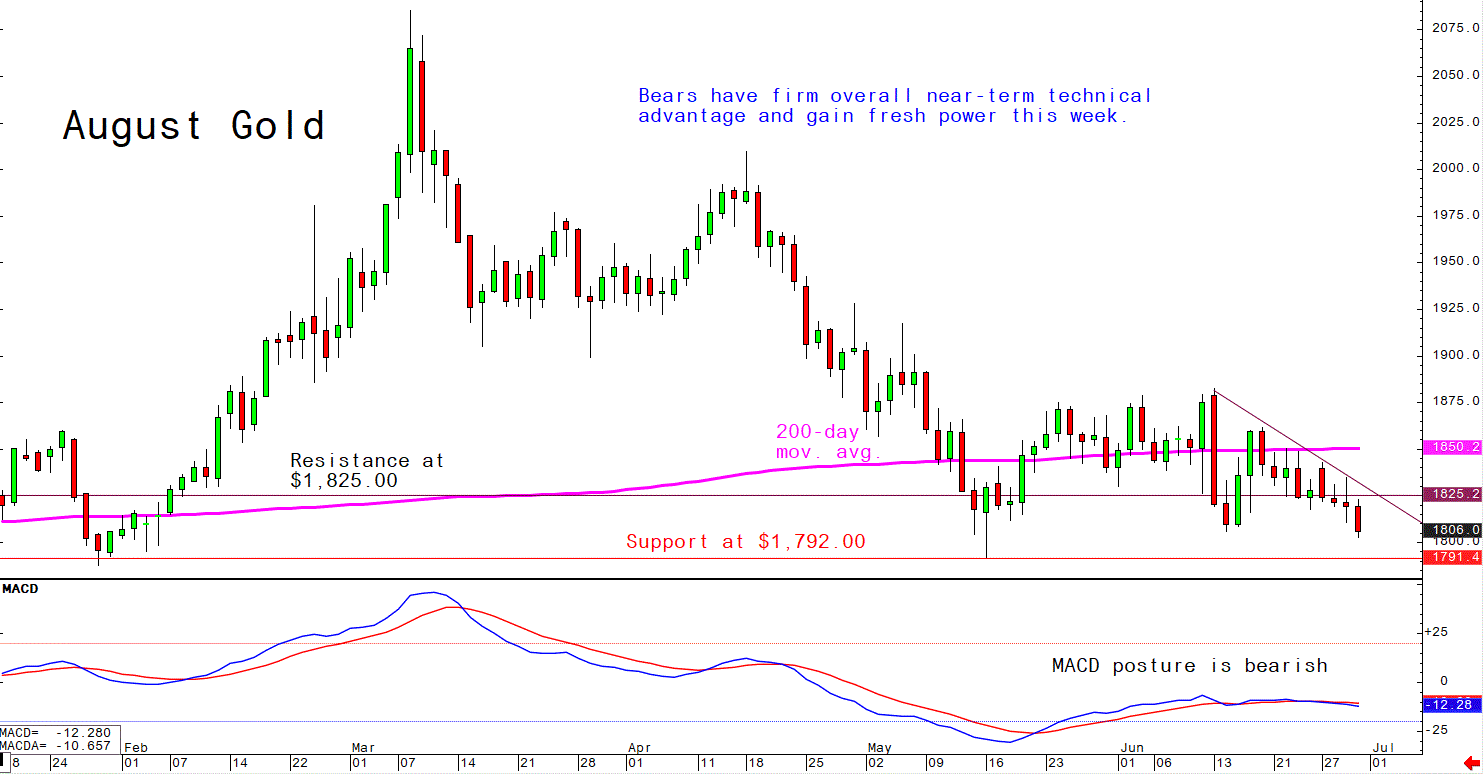
On tap today:
• U.S. consumer spending for May is expected to increase 0.4% from the prior month, and personal income is also forecast to rise 0.4%. (8:30 a.m. ET) UPDATE: U.S. household spending growth slowed in May as Americans faced historically high inflation with incomes that haven’t kept up with price increases. U.S. consumers boosted their seasonally adjusted spending by 0.2% in May, a slowdown from the revised 0.6% increase in April. Personal income grew by 0.5% in May, the same as April’s rate. Adjusted for inflation, after-tax income declined by 0.1% in May, showing that wage increases have been struggling to keep up with price rises. Inflation-adjusted spending declined by 0.4% in April. Core personal consumption expenditures prices, excluding food and energy, rose 4.7% from a year ago, slightly less than expected.
• Personal consumption expenditures price index excluding food and energy is expected to increase 0.4% from one month earlier and 4.8% from one year earlier in May. (8:30 a.m. ET) UPDATE: The index, a broad gauge of inflation in the economy, rose 6.3% in May on the year, unchanged from last month’s reading. The index is Fed officials’ preferred measure of rising prices and is likely to influence how aggressively they opt to raise interest rates at future policy meetings.
• U.S. jobless claims are expected to tick up to 230,000 in the week ended June 25 from 229,000 one week earlier. (8:30 a.m. ET) UPDATE: Weekly jobless claims totaled 231,000, a slight decline from the previous period.
• USDA Weekly Export Sales report, 8:30 a.m. ET. Link to report.
• Chicago purchasing managers index is expected to fall to 58 in June from 60.3 one month earlier. (9:45 a.m. ET)
• USDA reports: Acreage, Grain Stocks, noon ET.
• China's Caixin manufacturing index for June is out at 9:45 p.m. ET.
Powell: Soft landing for U.S. economy still possible, but no guarantee. Federal Reserve Board Chairman Jerome Powell on Wednesday said there was no guarantee that the central bank can engineer a soft landing for the U.S. economy. In a central banker panel discussion at the European Central Bank policy conference in Sintra, Portugal, Powell said, “We think that there are pathways for us to achieve the path back to 2% inflation while still retaining a strong labor market. We believe we can do that.” Still, Powell added there was “no guarantee that we can do that.”
Powell noted there is a “risk U.S. Federal Reserve interest rate increases will slow the economy too much, but the bigger risk is persistent inflation that starts to let public expectations about prices drift higher.” Powell said, “The clock is kind of running on how long will you remain in a low-inflation regime. ... The risk is that because of the multiplicity of shocks you start to transition into a higher inflation regime and our job is to literally prevent that from happening and we will prevent that from happening.”
Inflation- and recession-watch observations:
- About 90% of investors expect the U.S. to enter a recession before the end of 2023, according to a survey by Deutsche Bank published Thursday.
- The personal consumption expenditures price index, due to be released later today, should offer a broad gauge of whether inflation in the economy is peaking. The index is Fed officials’ preferred measure of rising prices and is likely to influence how aggressively they opt to raise interest rates at future policy meetings. In the April report, the PCE price index was reported up 6.3%, year-on-year.
- After initially discounting postpandemic inflation as transitory, the Federal Reserve and other global central banks have pivoted to making fighting it with interest-rate increases their most important priority, even if it means halting economic growth. Jerome Powell and other central bankers say forces that kept inflation low before the pandemic are unlikely to return.
- Mortgage applications to purchase a home dropped sharply last week and are now down 24% vs. last year. Meanwhile, a higher percentage of borrowers have been tapping adjustable-rate mortgages to reduce initial monthly payments.
- More low-income households surveyed by the Census Bureau are behind on rent as of early June.
- Cyclical cargo railcar loadings are indicating a slowdown.
- New Fed tracker shows rising strains in corporate debt. Gauge indicates pressure on investment-grade corporate bonds, though it remains far below levels hit in crises.
- Grocery and restaurant executives see inflation altering consumer spending. Whole Foods notes a shift among shoppers to less-costly items; General Mills prepares for possible increase in at-home dining. Meanwhile, some food companies say hiring challenges are starting to ease.
- Charles Scharf, the CEO of Wells Fargo, says the economy isn’t quite prepared for the future rate hikes the Fed has in store, as the central bank wages a battle against four-decade-high inflation. “We know rates are going up; it couldn’t be clearer,” he told CNBC at the Aspen Ideas Festival on Wednesday. “We know that consumers and businesses, while strong today, are going to see deterioration, and we’re going to act surprised when it happens.”
Market perspectives:
• Outside markets: The U.S. dollar index is firmer in early U.S. trading. In bond markets, the yield on the benchmark 10-year U.S. Treasury note fell to 3.052% from 3.091% on Wednesday. Brent crude, the international oil benchmark, edged down 0.5% to $111.91 a barrel. Gold prices edged down 0.3%.
• Bitcoin slid under $19,000 today before a slight rebound. The cryptocurrency, the world’s largest, is down 58% this year and off about 70% since its all-time high in November.
• OPEC+ ministers meet today to discuss production policy as oil prices approach their first dip since November. The oil cartel and partner nations are expected to approve a slight increase in August production by nearly 650,000 barrels a day. That level would be in line with what its members were producing before big cuts in early 2020. The decision comes ahead of a planned trip by President Biden to Saudi Arabia next month.
• California lawmakers passed a major, polarizing energy bill last night, making it easier for state officials to buy electricity from beachfront gas plants and diesel generators, and to approve solar and wind farms over the objections of local governments.
• European investments in liquefied natural gas are set to get another boost. More than 20 European LNG projects have been announced or accelerated since March, with the potential to replace about 80% of total imports from Russia in 2021, according to FTI Consulting.

• L.A. port chief sees no disruptions on eve of contract lapsing. The head of the US’ busiest port said he doesn’t foresee strikes at about 30 West Coast maritime hubs even as the labor contract for 22,000 dockworkers is about to lapse without a new deal. “Anything’s possible but it will not happen,” Port of Los Angeles Executive Director Gene Seroka said Wednesday.
• Acreage, Grain Stocks data out later today. USDA will release its Acreage and Grains Stocks Reports at noon ET. Based on a Reuters poll, analysts expect USDA to estimate plantings at 89.861 million acres for corn (89.490 million in March), 90.446 million acres for soybeans (90.955 million), 47.017 million acres for wheat (47.351 million) including 10.844 million acres of spring wheat (11.200 million) and 12.194 million acres for cotton (12.234 million). June 1 stocks are expected to total 4.343 billion bu. for corn (4.111 billion bu. on June 1, 2021), 965 million for soybeans (769 million bu.) and 655 million bu. for wheat (845 million bu.).
• USDA’s Hogs & Pigs (H&P) Report on Wednesday showed the June 1 inventory down 0.9%, with the marketing herd also down 0.9% and the breeding herd 0.8% smaller than year-ago. Those figures were virtually in line with traders’ expectations and should have no significant market impact this morning.
• Ag trade: South Korea purchased 136,000 MT of corn to be sourced from the U.S., South America or South Africa. Egypt purchased 815,000 MT of wheat, including 350,000 MT French, 240,000 MT Romanian, 175,000 MT Russian and 50,000 MT Bulgarian.
• NWS weather: A weak area of low pressure approaching the middle Texas Coast today will bring the threat of tropical downpours and flash flooding through early Friday... ...Severe thunderstorms to potentially impact parts of the northern Great Lakes and upper Mississippi Valley today and Northeast on Saturday... ...Monsoonal moisture and an approaching cold front to spread chances of locally heavy rain from the Southwest to the central Plains over the next few days.

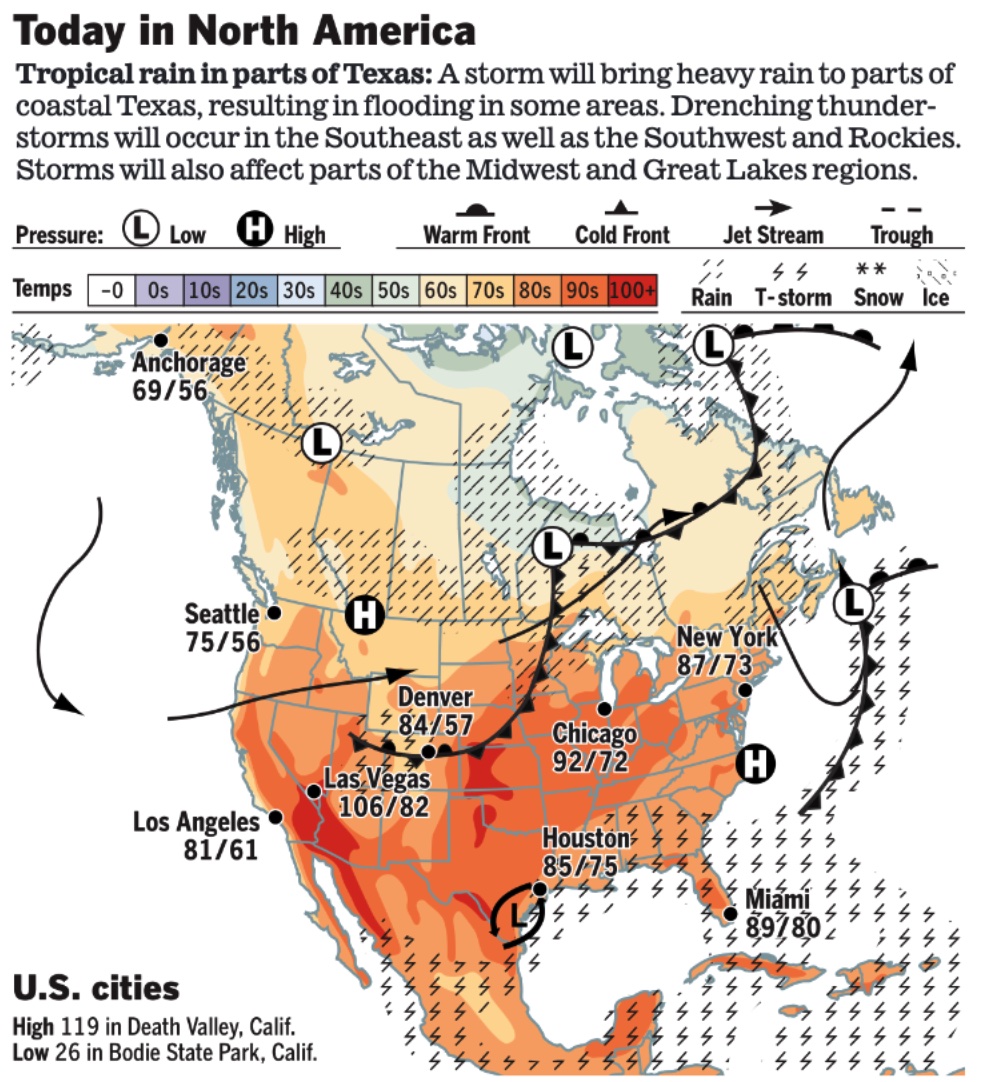
Items in Pro Farmer's First Thing Today include:
• Price pressure ahead of USDA reports
• Acreage, Grain Stocks data out later today
• Argentine trucker strike threatens grain exports
• Indonesia mulls raising palm oil mix in biodiesel
• China’s factory sector expands for first time in four months (details in China section)
• Cash cattle traded steady/firmer
• H&P Report mostly neutral
|
RUSSIA/UKRAINE |
— Summary: The U.S. promised to deploy more troops, warplanes and warships to Europe as part of NATO’s “fundamental shift” following Russia’s invasion of Ukraine. During a summit in Madrid the alliance agreed to fortify its eastern flank, declaring Russia to be its “most significant and direct threat.” President Joe Biden also backed the sale of American-made F-16 fighter jets to Turkey, a day after the country dropped its opposition to NATO membership for Finland and Sweden. Moscow is sending thousands more soldiers to eastern Ukraine to bolster its grinding campaign to control the last sovereign territory in Luhansk Province. Meanwhile, Russia and Ukraine exchanged nearly 300 prisoners of war, the largest exchange to date.
- Russian Foreign Ministry: Seizure of frozen assets will prompt retaliatory action. Reuters reports that Russia’s foreign ministry “hinted on Wednesday that it had not dropped the idea of seizing Western-owned assets and businesses in the country, as a top official sharply criticized governments that have hit Moscow with sanctions.” Reuters says that “in a combative media briefing,” Foreign Ministry spokesperson Maria Zakharova “warned that Russia was prepared to ‘act accordingly’ if the West decided to use Russia’s frozen state assets — chief among them being around $300 billion of central bank foreign currency reserves.” Zakharova is quoted as saying, “We should not forget about the foreign assets of Western countries, businesses and citizens who are located on the territory of our country.”
- Austria is preparing to seize one of Europe’s biggest natural gas-storage depots from Russia’s Gazprom as soon as tomorrow, when a new law enters into force that compels operators to fill the site’s capacity. The Alpine country gets about 80% of its gas from Russia and its export-heavy economy is counting on flows for at least another five years.
- Russian forces withdrew from Snake Island, a tiny but strategically important chunk of Ukrainian territory in the Black Sea. Russia called the move a “gesture of goodwill” to show that it is not blocking food exports by sea from Ukraine. But Ukraine claims it forced the occupiers into a hasty retreat, having in recent days intensified its efforts to remove them.
— Market impacts:
- The Russian ruble, in a free fall earlier this year, has soared to a roughly seven-year high against the U.S. dollar.
- Canada in talks with Europe about east coast energy exports: foreign minister. Canada is in talks with its European allies, including Spain and Germany, about exporting oil and gas from its east coast to alleviate energy constraints and provide an alternative to Europe's Russian energy imports, Foreign Minister Melanie Joly said.
- Europe is rushing to rebuild natural gas reserves amid deep cuts in Russian supplies, but it’s walking a thin line to avoid a winter energy crisis. With a target of ensuring inventories are 80% full by Nov. 1, EU countries are boosting energy savings, buying more liquefied natural gas and subsidizing the rapid restocking of storage sites. While storage filling rates are on track to hit 90% by November, the EU still faces a range of obstacles in meeting its gas reserves’ goal. A deal to end Russia’s blockade of Ukrainian seaports and grain exports remains distant because Moscow is using talks to push its war aims and ambition to dominate the Black Sea, Kyiv’s top negotiator said. Turkey and the U.N. are trying to broker an end to Russia’s naval blockade in the Black Sea, which has crippled Ukrainian commodity exports and triggered fears of global food shortages. But Taras Kachka, Ukraine’s deputy minister for the economy and lead trade negotiator, said Russia’s efforts to conquer the country’s south were preventing a deal and rumors of a breakthrough were “more optimistic than reality… If there are talks, we will participate. But that doesn’t mean we will agree to any option that is on the table,” Kachka said. “Any attempts to base a food security solution on the goodwill or grace of Russia will not work or be trusted.”
“Grain as a commodity is better than gas because the demand is not flexible. For gas, you can just switch to coal. Everyone needs bread,” Kachka added.
Russian missiles struck Odesa, Ukraine’s biggest port, on Monday, part of a wave of aerial attacks across the country.
Kachka said Ukraine would accept a third country’s naval presence to escort vessels, including “Her Majesty’s fleet or the US or Turkey”. But western countries are opposed to direct confrontation with Russia, despite their financial and weapons support for Ukraine. Russian smugglers have already been exporting grain looted from Ukrainian territory in recent weeks.
A government official in Kyiv told Politico that a plan is under discussion that would open blocked Ukrainian ports, without the need to de-mine the waters in the area. A security guarantee provided by Turkey or another state — likely one within NATO — is now the crucial missing piece of a deal and a plan could be finalized within days, the official said.
|
POLICY UPDATE |
— More than $4 billion have been paid out in ERP payouts to date. It looks like USDA again waited for USDA Secretary Tom Vilsack to travel or give testimony to Congress to announce a major development. This time Vilsack was in Minburn, Iowa, in a district where Democratic Rep. Cindy Axne could well face a tough campaign. Vilsack announced that to date, agricultural producers have already received more than $4 billion through the Emergency Relief Program (ERP), representing approximately 67% of the more than $6 billion projected to be paid through Phase 1 of the program. USDA mailed out pre-filled applications in late May to producers with crop insurance who suffered losses due to natural disasters in 2020 and 2021. Commodity and specialty crop producers have until July 22 to complete applications.
Vilsack comments. “We recognize the financial recovery need is great and worked deliberately to create a program delivery process that would ensure quick payments to producers,” Vilsack said. “I am extremely proud to share that the strategically streamlined ERP application and program implementation process have yielded the desired results – reduced burdens on and expedited payments to approximately 120,000 disaster-impacted agricultural producers, to date.”
As previously noted, USDA is implementing ERP and ELRP in two phases, with Phase 1 utilizing existing claim data to provide relief expediently, and Phase 2 focusing on ensuring producers not covered by other programs receive assistance. For Phase 1, USDA used crop insurance and Noninsured Crop Disaster Assistance Program (NAP) claim data.
Both ERP and the previously announced Emergency Livestock Relief Program (ELRP) are funded by a bill President Biden signed into law in 2021. The law provided $10 billion from taxpayers to help agricultural producers impacted by wildfires, droughts, hurricanes, winter storms and other eligible disasters experienced during calendar years 2020 and 2021, of which $750 million is committed to livestock producers who experienced losses to drought or wildfire in calendar year 2021. Eligible livestock producers received ELRP payments totaling more than $590 million since the program was rolled out in late March.
Additional Assistance through Phase 1. FSA will be sending pre-filled applications for about 9,000 eligible producers with NAP coverage in mid-July. The federal crop insurance data used to populate ERP Phase 1 pre-filled applications included claim data on file with USDA’s Risk Management Agency (RMA) as of May 2, 2022. At that time, claim data for the Supplemental Coverage Option (SCO), Enhanced Coverage Option (ECO), Stacked Income Protection Plan (STAX), Margin Protection Plan (MP) or Area Risk Protection Insurance (ARPI) were not complete, so crop/units including these coverage options were not included in the pre-filled ERP application form. In late summer 2022, updated claim information will be used to generate a second pre-filled application for those crop/units with eligible losses on file with RMA not included in the first mailing.
All producers who receive ERP Phase 1 payments are statutorily required to purchase crop insurance or NAP coverage where crop insurance is not available for the next two available crop years.
Phase 2 of both ERP and ELRP will be aimed at filling gaps and providing assistance to producers who did not participate in or receive payments through the existing programs that are being leveraged for Phase 1 implementation. USDA said it will keep producers and stakeholders informed as program details are made available.
— As expected, USDA Secretary Vilsack taps CCC for $1 billion for school meal programs. The Biden administration announced today USDA will provide nearly $1 billion in additional funding to schools to support the purchase of American-grown foods for their meal programs. The $943 million boost from the department is provided through USDA’s Commodity Credit Corporation. Funds will be distributed by state agencies to schools across the country, so they can purchase domestically grown foods for their meal programs. This assistance builds on the $1 billion in Supply Chain Assistance funds USDA previously allocated in December 2021, which states can use this school year as well as next to provide schools with funding for commodity purchases. Link for more information.
— USDA sends OMB proposed rule for new approach to determining livestock indemnities. The USDA documents also provides for a new framework for the indemnity regulations relative to removing animals that the Animal and Plant Health Inspection Service (APHIS) classifies as “affected, suspect, or exposed to diseases of concern, to eradicate and control foreign animal diseases, emerging diseases, and program diseases.” The rules currently in place “specify values for animals removed for these diseases or the process to determine values if a flat rate was not established, methods of identification, confirmation of destruction, and other aspects of removal,” according to a summary of the regulation. It can cover multiple species in each section based on the disease covered. USDA’s goal is to release the advanced notice of proposed rulemaking (ANPRM) in September with a 60-day comment period.
— Democratic leaders still discussing another budget reconciliation measure. Senate Democrats are working to reduce the tax increases on U.S. corporations and wealthy households in President Joe Biden's economic package to appease centrist Sen. Joe Manchin (D-W.Va.) and get the approximately $1 trillion spending bill passed in the coming weeks, Bloomberg reports (link), citing people familiar with the discussions. As part of the Manchin-aimed compromises, Democratic leaders have also finalized a proposal to lower prescription drug prices for seniors, empowering the federal government to negotiate the price of specific drugs on behalf of Medicare beneficiaries, the Washington Post reports (link), citing three people familiar with the matter.
|
PERSONNEL |
— Justice Stephen Breyer is officially retiring today at noon ET. Breyer will be replaced by Ketanji Brown Jackson, the first Black woman to serve as a Supreme Court justice.
|
CHINA UPDATE |
— Commerce Dept. adds five Chinese firms with ties to Russian military to blacklist. Reuters reports “the move came for allegedly supporting Russia’s military and defense industrial base, flexing its muscle to enforce sanctions against Moscow over its invasion of Ukraine.” The Commerce Department, which oversees the blacklist, said the targeted companies had supplied items to Russian “entities of concern” before the Feb. 24 invasion, adding that they “continue to contract to supply Russian entity listed and sanctioned parties.’” Commerce also added another 31 entities to the blacklist from countries that include Russia, UAE, Lithuania, Pakistan, Singapore, the United Kingdom, Uzbekistan and Vietnam, according to the Federal Register entry. Of the 36 companies added, 25 had China-based operations.
— China’s president, Xi Jinping, arrived in Hong Kong for events celebrating the 25th anniversary of the territory’s handover from British to Chinese rule. In preparation for the anniversary, on July t, many of the city’s streets and buildings have been adorned with red Chinese flags. It is Xi’s first trip outside of mainland China since the pandemic began, and his first visit to Hong Kong since 2017. In a brief opening speech, Xi said Hong Kong had “risen from the ashes” after overcoming various severe challenges since his last visit in 2017, which also proved “one country, two systems” was a good system.
— Economic activity in China expanded in June after three straight months of contraction, according to official surveys of businesses and factories that point to a modest recovery after Covid-19 restrictions were eased in the world’s second-largest economy. Economists are downbeat about the prospects for a major revival, however, given the darkening global backdrop and the risk of further Covid outbreaks. China’s official purchasing managers index for nonmanufacturing sectors posted a reading of 54.7 in June, a big jump from the previous month’s 47.8, the National Bureau of Statistics said Thursday. The surge was led by a rebound in construction and the services sector, where the lifting of Covid-19 restrictions unclogged transportation blockages and allowed people to return to stores and restaurants. The reading was the highest since May last year. Manufacturing activity returned to growth, but the rebound was weaker than economists were anticipating. The purchasing managers index for the manufacturing sector rose to 50.2 from the previous month’s 49.6. A reading above 50 indicates activity is expanding rather than shrinking.
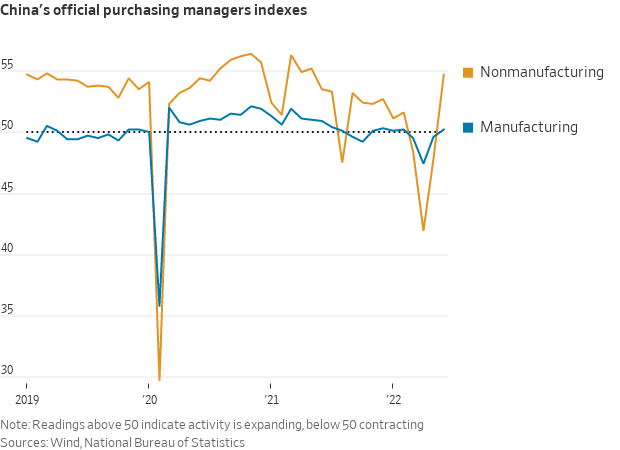
— China must keep cuts to interest rates, RRR as policy tools to boost economy. China’s central bank needs to use all of its policy options in supporting an economic recovery, a former senior official at the country’s foreign exchange regulator said. “Before the economy returns to a reasonable growth range, it is necessary to maintain sufficient policy tools, among which RRR (bank reserve requirement ratios) and interest rate cuts should still be policy options,” Guan Tao, global chief economist at BOC International and a former official at the State Administration of Foreign Exchange, was quoted in a report by state-run Shanghai Securities News. “The time window for China's monetary policy does not depend on the Federal Reserve's interest rate hike, but rather on the actual state of domestic economy,” Guan said.
|
ENERGY & CLIMATE CHANGE |
— Interior holds Biden administration’s first oil, gas lease sale. The Interior Department on Wednesday auctioned 105 oil and gas leases on federal lands in Wyoming — the first onshore oil and gas lease sale since the final days of the Trump administration.
— Global demand for biofuels to slow in decade ahead: report. Corn will become less important and sugarcane a more dominant feedstock for making ethanol in the coming decade, according to an agricultural outlook published jointly by the OECD and FAO on Wednesday. The report (link) forecast a relatively slow growth rate for biofuels, averaging 0.6% a year worldwide, with growth in the U.S. constrained by declining gasoline consumption.
India is forecast to account for half of the additional global consumption of ethanol through 2031, and consumption would also continue to climb in Brazil. Both nations use sugarcane as their feedstock. By 2031, nearly a quarter of sugarcane would be used to make biofuels. India has a goal of 20% ethanol — E20 — in all of its gasoline.
“In China and the United States, growth prospects for ethanol consumption are limited,” said the OECD-FAO report. China proposed an E10 mandate in 2017, but its shrinking corn stockpile is expected to deter implementation. “It is assumed that China will maintain a lower 2 percent blending rate over the projection period,” said the report. “In the United States, declining gasoline use, together with the 10 percent ethanol blend wall, will constrain growth in ethanol consumption.”
Biodiesel consumption is projected to increase 7% by 2031, with Indonesia accounting for 77% of the growth. The nation has a goal of a 30% mix of vegetable oils in diesel fuel. “In the United States and the European Union, however, declining diesel use will constrain the growth in biodiesel consumption,” said the report.
— House Energy chairman calls for selective halt in U.S. oil exports. House Energy and Commerce Chairman Frank Pallone (D-N.J.) has joined some other Democrats in urging President Joe Biden to halt U.S. oil exports to ease energy prices in the U.S. In a letter to Biden, Pallone notes the downturn in U.S. refining capacity since the crude oil export ban was repealed in 2016. Pallone said exports of U.S. crude “have increased profits for fossil fuel producers each year to the detriment of domestic refining investments and lower prices for consumers.” Pallone urged Biden to halt shipments to non-allied countries but keep “exports that directly help Ukraine and other U.S. allies weather the effects of Russian aggression.” Such a move would require a national emergency declaration which seems unlikely as such an export ban would still be viewed as tightening global oil supplies and could well raise prices at the same time the U.S. and other allies are urging countries not to ban key agricultural exports.

— AFPM outlines new refining capacity, urges no export ban in letter to DOE’s Granholm. The American Fuel and Petrochemicals Association (AFPM) and American Petroleum Institute (API) informed Energy Secretary Jennifer Granholm in a letter that the U.S. refining industry is planning to bring some 300,000 bpd of new refining capacity on line next year. The also argued against any export ban. “The most important near-term action the administration can pursue is to unequivocally take counterproductive policies and rhetoric off the table,” AFPM CEO Chet Thompson and API CEO Mike Sommers said. “Policies like export bans or windfall profit taxes may not only hamper the industry’s ability to fully supply the market, but also create the uncertainty that dissuades potential new investments needed to increase domestic energy production.” They stressed the Biden administration should end “accusations of profiteering.
|
LIVESTOCK, FOOD & BEVERAGE INDUSTRY |
— Food for undocumented residents. California is expected to become the first state to offer food benefits to immigrants residing illegally in the state, although the aid would be limited to those over 55. Link to details via the Los Angeles Times.
|
CORONAVIRUS UPDATE |
— Summary:
- Global Covid-19 cases at 546,453,228 with 6,334,451 deaths.
- U.S. case count is at 87,411,073 with 1,017,468 deaths.
- Johns Hopkins University Coronavirus Resource Center says there have been 592,269,252 doses administered, 221,924,152 have been fully vaccinated, or 67.35% of the U.S. population.
— Dr. Anthony Fauci, 81, tested positive again despite having taken Paxlovid, but emphasized that the drug had probably kept him from being hospitalized.
|
POLITICS & ELECTIONS |
— Biden hits new low in polls, worse than Trump. The RealClearPolitics average of polls on Wednesday showed Biden's job approval rating plummeting to 38% for the first time since he became president a little more than 17 months ago. Those who disapprove account for 57.5%, making for a 19.5-point split. At a time when the economy is feeling the pinch of rising inflation and high gas prices, Biden's numbers on the economy are similarly poor. The RCP average shows his job approval in that area at 33.4% approving and 62% disapproving.
— Trump not challenging core allegations in Hutchinson’s testimony to Jan. 6 panel. The Wall Street Journal (link) cites former federal prosecutors and legal scholars who say the testimony of Cassidy Hutchinson, an aide to former President Donald Trump’s chief of staff Mark Meadows, to the House Jan. 6 committee could support criminal charges against Trump. Similarly, the AP (link) says “legal experts believe the testimony, presuming it can be corroborated, does give prosecutors avenues to pursue.” But, in an op-ed for the New York Times (link), Norman Eisen, who served as special counsel to the House Judiciary Committee during Trump’s first impeachment trial, writes that although “the evidence is powerful,” it is “not yet sufficient to overcome the very high bar of proving, beyond a reasonable doubt, that Mr. Trump agreed with the rioters to attack the Capitol.”
— Youngkin’s NYC meeting with big GOP donors prompts presidential speculation. The Washington Post reports (link) Virginia Gov. Glenn Youngkin (R) “flew to New York last week to meet privately with GOP megadonors in Manhattan, a move that underscores recent hints that the Republican is considering a run for president in 2024.” According to the WaPo, “The day-long visit, which was not listed on Youngkin’s public calendar and included a trio of national TV interviews, comes as the new governor prepares to headline his first out-of-state political event since taking office, with an appearance next week in Nebraska. He also has begun speaking more often about the needs of ‘Americans,’ not just ‘Virginians,’ and has subtly changed how he answers questions about whether he will seek the White House.” The WaPo says Youngkin “used to respond that he is solely focused on his new job in Virginia,” but “more recently, he’s begun saying he is ‘humbled’ that so many people ‘request’ that he run.”
— A New York Supreme Court judge lifted a civil contempt order against former President Donald Trump on Wednesday, according to multiple reports, which stemmed from the ex-president's refusal to comply with a state investigation into potential fraud by the Trump Organization.
|
CONGRESS |
— McConnell comments on divided government. Senate Minority Leader Mitch McConnell (R-Ky.) told an audience in Hazard, Ky., that he would seek to compromise with President Joe Biden if Republicans take the Senate in November. McConnell said he would “look for issues within the 40-yard line” to “make some progress for the country… I’ve never been in favor of doing nothing at all and sitting there and fighting all the time,” McConnell said. “That’s never been something I’ve been in favor of.” McConnell often says that the American people prefer divided government – and he has served with presidents of a different party for many years.
What McConnell sees ahead: “Let’s look for some things that we can agree on. Because we’re not going to do the big stuff [Biden] wanted to do that took us in the wrong direction. Because we don’t have the White House, we won’t be able to do it exactly like we want to do it. But the country, I think, when they give you a divided government is saying, ‘Okay, we know you have big differences. We want you to look for the things you can agree on, try to do those.’”
|
OTHER ITEMS OF NOTE |
— Two SCOTUS rulings coming today. The Supreme Court announced that today will be the last decision day for the summer term. The court has left two controversial cases until today: rulings on whether President Joe Biden’s administration can end the “Remain in Mexico” border policy and a major case on the EPA’s power to tamp down on greenhouse gas emissions. on a pivotal case that could drastically alter the EPA’s ability to regulate on climate change. The EPA case, West Virginia v. EPA, centers on whether the Environmental Protection Agency overreached in regulating greenhouse gas emissions from power plants under the Clean Air Act. At stake is whether EPA has the authority to regulate “beyond the fenceline,” meaning a wider sector approach versus plant-by-plant. But more broadly, justices can deal a major blow to the EPA’s and other federal agencies’ regulatory ability.
— The Israeli parliament, the Knesset, has voted to dissolve itself, triggering what will be the fifth round of voting for Israelis in less than four years. The 92-0 vote today brings an end to Prime Minister Naftali Bennett's run as the country's leader -- one of the shortest terms in Israeli history — and gives former Prime Minister Benjamin Netanyahu a path to return to power.
— The publisher Macmillan suffers a cyberattack. Booksellers said they were unable to place orders with the publisher, one of the nation’s largest, the Wall Street Journal reported. The company said it had “recently experienced a security incident, which involves the encryption of certain files on our network,” and was working to restore its systems. Meanwhile, NATO pledged to create a rapid response cyberforce and to boost cooperation between militaries, industry and civil society in a bid to counter cyberattacks from adversaries like Russia and China. In a joint declaration, leaders of all 30 NATO countries said they would work to boost Ukraine's cyber resilience in the face of Russian aggression, in a move experts said represents a more substantive response to the threats posed in cyberspace.






